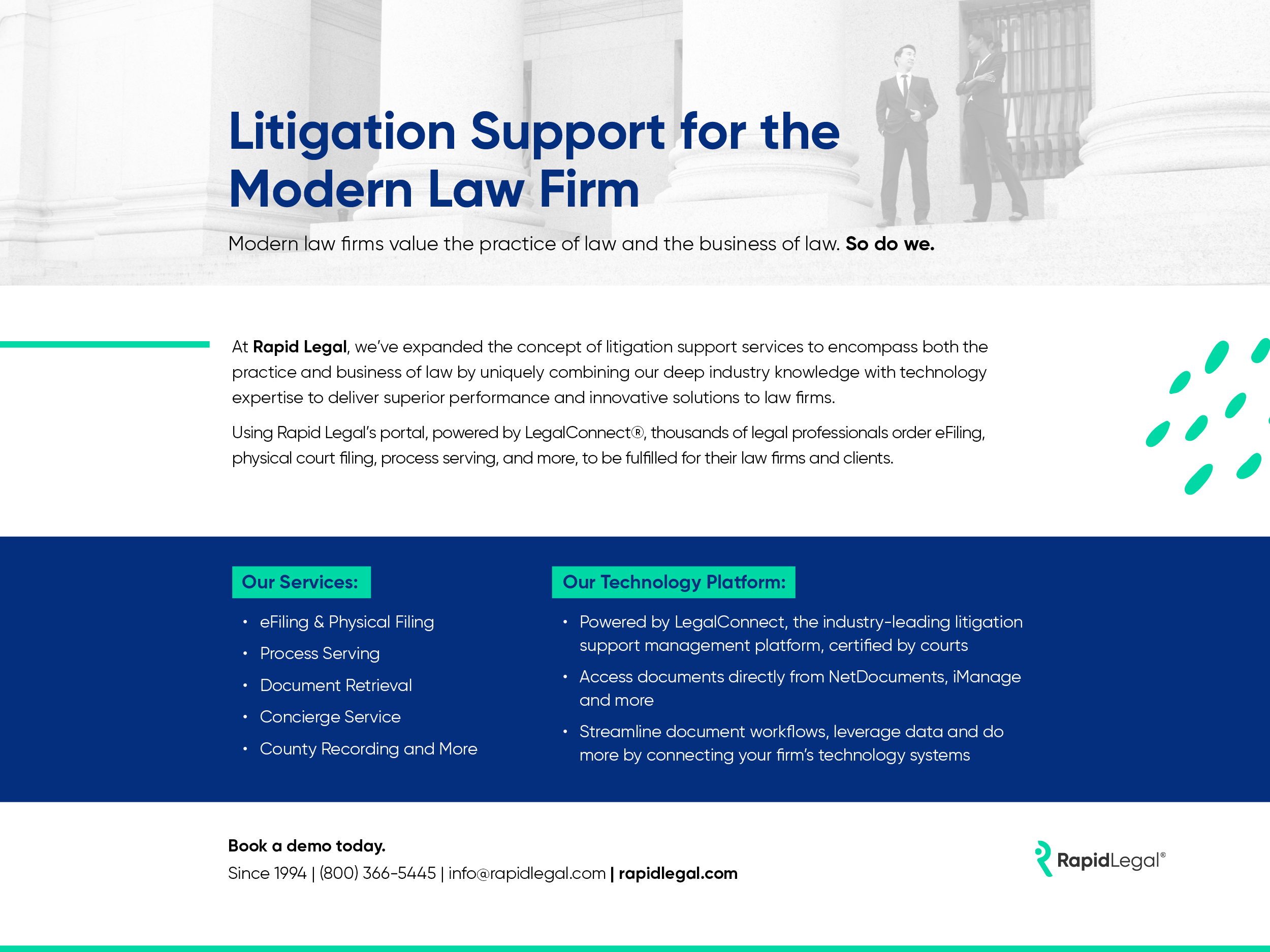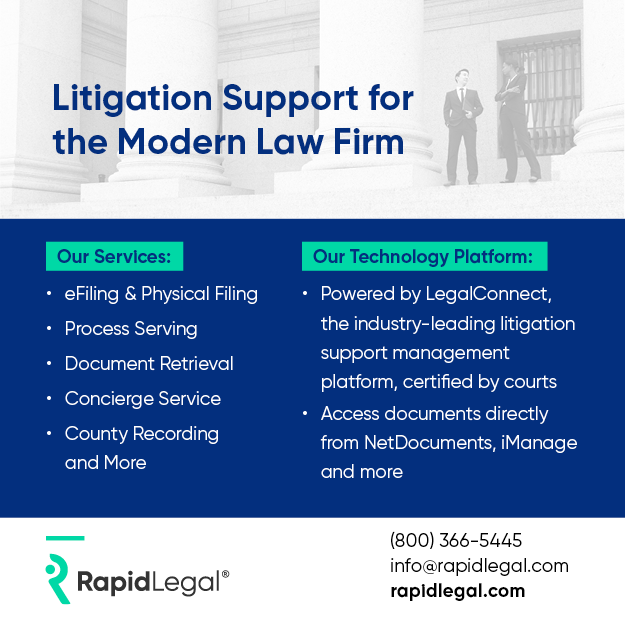“Perhaps your caseload has increased, and you need extra attorneys to handle the steady stream of new business, or possibly you require the assistance of an expert on a particular project,” says Kelley Brubaker, a CPA and business coach in Akron, Ohio, who helps law firms scale profits and become more efficient.
Whatever your circumstances, determining what you require is the first step toward optimizing your processes. Assuming you have a firm grasp on your needs, the next phase is to identify the best places for making a change. “This may necessitate the recruitment of new legal counsel, like lawyers, paralegals or even outside counsel. Finding people [who] will be appropriate for the job and can aid you in accomplishing your objectives is important,” says Brubaker.
Here are just some areas in which a new process can make your practice more efficient.
1. DOCUMENT PROCESSES WITH STANDARD OPERATING PROCEDURES
Brubaker requires her clients to document their standard operating procedures (SOPs), from adding a new prospect to their customer relationship management (CRM) database to the entire client intake process. “You never know when someone will be out of the office unexpectedly and we want to ensure the office does not fall apart when key people are unreachable,” she says.
The best SOPs include detailed step-by-step instructions, FAQs addressing the “whys” of the process, and boundaries of what a staff person can do without asking permission from a manager or partner.
“Empowering staff to make decisions without direct input or oversight from firm partners is the foundation of every efficient law firm,” says Brubaker.
2. HOME IN ON CLIENT INTAKE
Brubaker notes the next thing she works with clients on to boost efficiency is client intake. That starts with the right CRM. While any CRM can work, the ones specific to law firms that include case management tools will make office life much easier in the long run.
These systems efficiently gather necessary information, minimize the risk of errors and reduce administrative burdens. By automating this process, legal managers can allocate their time and resources more effectively, focusing on providing high-quality legal services to clients.
For every prospect, it’s critical to gather as much contact information as possible and enter it into the CRM. “I ask that the managing partner define the ‘critical information’ required from prospects. Most firms choose the same contact information such as name, address and phone, but some firms have an established marketing system based either on email or a social media platform,” Brubaker explains. Getting the critical information will allow the firm to place every prospect into the marketing system for automated nurturing.
“The best SOPs include detailed step-by-step instructions, FAQs addressing the ‘whys’ of the process, and boundaries of what a staff person can do without asking permission from a manager or partner.”
Having all prospects in your CRM will make the client intake process smoother because there will be less information you need to obtain from clients going forward. You can streamline the client intake process by making one person (plus one backup person) responsible for ensuring all information is entered when the firm retains a new client.
“I have found when there is not a key responsible person at this step, cracks in the process will start to appear,” says Brubaker.
Once you have all pertinent information in your CRM, generating your fee or retainer agreement can be done in minutes, emailed to the new client, and tracked within the CRM for digital client signature and filing. Opening new matters for this client can be accomplished easily afterward.
3. EMBRACE ADVANCED TECHNOLOGY TOOLS
Legal managers should leverage cutting-edge software applications designed specifically for law firms to streamline tasks and enhance efficiency. One area where technology has significantly impacted workflow management is integrating advanced technology tools and software for daily workflows.
“Legal project management tools allow us to track and allocate tasks, set deadlines and monitor progress in real-time. This not only improves communication and collaboration among team members but also ensures that cases are handled promptly and efficiently,” says Mike Schmidt, Esq., an attorney at Schmidt and Clark. By adopting these tools, legal managers can better allocate resources, manage workloads and identify potential bottlenecks before they become significant issues, he explains.
Collaboration has also been revolutionized by using cloud-based platforms and virtual meeting tools. These technologies enable attorneys to work seamlessly with clients, co-counsel and support staff regardless of their physical location.
Real-time document sharing, instant messaging and videoconferencing all facilitate smooth and effective communication, reduce delays and improve productivity. Collaboration is no longer limited to in-person meetings, allowing for greater flexibility and efficiency in working with multiple parties simultaneously.
“One area where technology has significantly impacted workflow management is integrating advanced technology tools and software for daily workflows.”
Technology has also improved and enhanced efficiencies related to billing. If your firm isn’t billing electronically, moving to this format can simplify invoicing and reduce the time spent on manual data entry and paperwork.
“These systems integrate with case management software, allowing for accurate and timely recording of billable hours and expenses. Clients can receive invoices electronically, making payment processes more convenient and expediting the overall billing cycle,” says Schmidt.
4. HARNESS AI-DRIVEN E-DISCOVERY
Like most other industries, law firms are also finding ways to harness artificial intelligence (AI) to improve processes and speed things up.
“Something that my firm has adopted is AI-driven e-discovery. These days, there is rarely any case that doesn’t involve some aspect of the plaintiff’s/defendant’s digital footprint,” says Ben Michael, Esq., an attorney at M&A Criminal Defense Attorneys. “Without the help of AI, e-discovery investigations can’t be completed as efficiently. When you can’t do that, you’re not representing your client as best as you can.”
In addition, AI can process massive amounts of text to look for relevant legislation, case law and precedent.
“Even in cases where these systems can’t go so far as to recognize patterns or suggest a legal strategy, they can at least flag relevant documents for further review by paralegals. This has been extremely useful for my team when we are extra busy or short-handed and need that extra help — and truthfully, it’s helpful even when we aren’t as pressed,” says Michael.
5. DON’T DISCOUNT OFFICE DESIGN
Finally, law offices often sport a nonfunctional design layout like squeezing past file cabinets on your way to the copier, bad lighting or “meh” furnishings. While you might not think office design affects efficiency, changes like making shared equipment more accessible and creating collaborative workspaces that match the needs of the attorneys and staff, instead of walled-off corner offices can improve collaboration.
Cloud-based storage, pops of color and comfortable chairs are shown to decrease the need for time off and shorten breaks, notes Cain Elliott, PhD, Head Legal Futurist and Senior Vice President at Filevine.
ON YOUR WAY TO EFFICIENCY
As firms continue to struggle with hiring and retention, improving the way staff works shouldn’t be overlooked. Creating a smoother-running, more efficient office and implementing some of these processes can help your practice streamline workflows — and make life easier for everyone.


